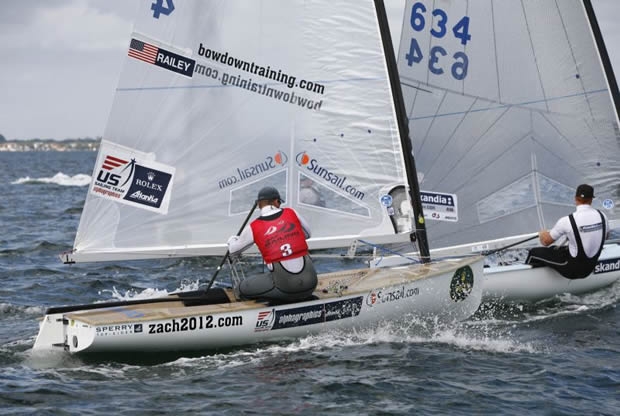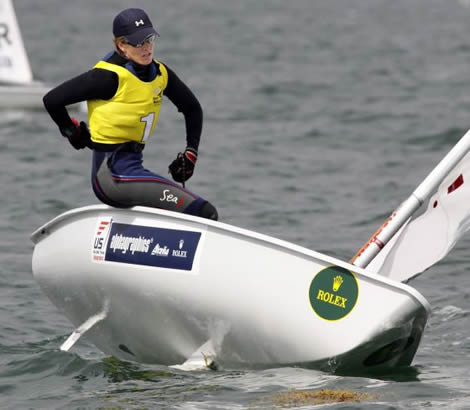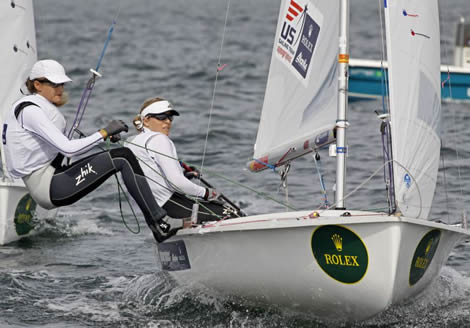
Return of the sailing giant pt 2
This article follows on from part 1 here
Brenner says that for philosophical reasons they will never provide 100% of a sailor’s budget. “I am a firm believer that you have to own your own success, whatever you are doing in life. Whether it is business or sailing or whatever, if you don’t have skin in the game, have ownership of the outcome, sweat equity, you aren’t going to care as much. It is just human nature. Our target is to give our sailors most of what they need, but they have to fight and scratch and claw for the rest. We think it breeds a tougher mentality and I want them all when they are on the water to look around and feel like they worked harder to be there than anyone else, because that gives you a confidence in that final moment, that you are in charge of your own destiny. The sailor who have been handed everything, that sailor, while a finely conditioned athlete, maybe isn’t as mentally strong.”
To help sailors stand on their own two feet in the US, they also have to manage their own campaigns. For example while coaches and shipping are paid centrally, sailors are given their budget cheque and it is up to them to manage it. “Take this amount of resource and translate it into success on the water – figure it out, or we can help you figure it out,” says Brenner. “Potential donors in America are less interested unless that is the case. Americans don’t like a welfare system, When I am out there raising money, you are not funding a coddled professional team.”
Compared to the old way things were run, a lot more of the logistical side of the US’ team Olympic campaigns are now run centrally. Brenner cites their set-up in Weymouth last week: “We are here with physical trainers and a weather guy, one or two coaches in every class. We have a press officer and team photographer and videographer. We have raised the funding, the level of service, the look of the team. We had a team dinner with everyone dressed in their team uniform. And the sailors are excited. They love the team atmosphere. It is lonely to travel on your own and be responsible for everything on your own.” They also organise all the shipping, and the team offer sailors a place to store boats and gear in both Weymouth and on the continent, while they are in Europe.
A potential problem for the US team is the sheer size of the country. While British sailors have the luxury of the facility in Weymouth with most of the Olympic team living in the vicinity, in the US sailors come from all over.
To get around this, since Kenneth Andreasen’s appointment they have been placing more emphasis on training camps scheduled to take place where there is already a gathering of their sailors – such typically before most regattas such as Skandia Sail for Gold and Kielerwoche. Prior to Beijing such camps didn’t take place, with Olympic sailors each making their own coaching arrangements. “Now not only are we wearing the same clothes we are working together under the same coaches.”
Selection
As mentioned the US team is now looking outside of their country and significantly for the first time this is also translating to their sailing team selection for the Games. Previously up until Beijing selection worked on a winner-takes-all, sudden death arrangement at a single regatta. Now selection will be based upon the best combined performance at the next Skandia Sail for Gold to be held in June 2011, followed by the ISAF World Sailing Games in December 2011. But in fact with the number of spots available for Sail for Gold to be limited next year, the qualification process to get a berth in that regatta will be the combined results of Rolex Miami OCR, Princess Sofia, Hyeres and the Delta Lloyd regatta. “So in essence our trials start in January,” says Brenner.
Brenner says that the change to this new procedure has been necessary, but still defends the old sudden death system. “If you have the right quality and quantity of fleet, I think it is still the best model. Any sailor that grew up in the US and went to the Olympics in the 1980s or 1990s, will tell you that that single trial system did the best job of replicating the pressure of the Games. I won’t argue with that.”
They were considering introducing the change in selection process for Beijing, but instead they only trialled it with the Yngling where Sally Barkow’s team got the nod after their performance at the 2007 and 2008 Yngling Worlds. This time all will be decided after Perth, with the exception of the Women’s Match Racing. Even the top teams rarely get more than two berths for the Women’s Match Racing at Olympic class regattas, but at present there are three US teams gunning for the slot – including Barkow once again, but also Beijing Laser Radial Gold medallist Anna Tunnicliffe and Jenny Tulloch. So these teams will take part in an open match racing event for around ten or 12 boats, to be held in Elliott 6s in Miami in December 2011 or January 2012. This will whittle the teams down to four who will then battle it out in a final trials in the Elliotts in May 2012.
Development
Brenner hopes that at some point over the next few years of their ‘plan’ they can set up a Weymouth WPNSA type facility in the USA either in Florida or California, but most probably Florida. “No matter where you hold training in the USA, someone has to travel and someone is going to complain.” Or it may be that they can regionalise the US when it comes to training.
Another strong point with Skandia Team GBR is the youth program that churns out future Olympians. In the USA the system is slightly different – it is only in the last three years that they have set up a ‘development team’.
“That is the only part of our program that is entirely subjective,” says Brenner. “You can’t sail your way on to it. We choose. We get everyone to send us their resume by a certain date in the fall and we interview. We make it clear what our expectations our. We show them the schedule. Then it can be up to 50 sailors.”
This year they have 43 in their development team across a range of classes. Significantly there is no age limit on this – Brenner points to one former Olympic team sailor who had a rotten season in 2009 and so was put into their development team. But more likely someone in a development sailor will be an up-and-coming 15 year old.
Those on the development program have their own training camps, but their sailors are also invited to all the elite squad’s training camps. So Brenner says while they receive little money, they are helped with logistics, shipping costs and have access to top level coaching. “They get education on how to compete as an athlete at this level, from on the water to how you set up your own program. I teach them how to raise money and they get an opportunity to train side by side with our elite sailors and they get a lot of moral support. They love it and they get to wear the shirts and they feel like they are part of it. So our Radial development sailors are training alongside Paige Railey and getting the Olympic coaching and they think it is awesome.”
Due to the size of the USA, there is no centralised Junior program. Instead this is typically run locally. “Southern California has a great youth sailing program and there’s another in Long Island Sound - there are great youth pockets all over,” says Brenner. “It is possible we’ll decide that we ourselves don’t have to go lower, rather just maintain relationships with all these youth groups and pick and choose from the best of the best.”
The future
Looking forwards Brenner says that they wish to continue to grow their income from corporate and private donors. They are to introduce a new revenue stream based on events where there is a regatta and dinner where boat owners can get to go racing with Olympic sailors. At one of these they raised $150,000 alone.
As to their medal target for 2012, Brenner says they have them and as is the case with the approach of other teams it is more a case of developing the number of sailors and classes where there is the potential to medal as after this it comes down to statistics.
“There are a couple where we won’t compete,” says Brenner of 2012. “We’d like to be in the hunt in five or six at least and in 2016 at least seven or eight. How may medals that translates into... You could argue that going into 2008 we were legitimate medal hopes in only three events – the Radial, Anna [Tunnicliffe] was no1, the Yngling, they had been on the podium four or five times and in the 49er with Tim and Chris. Only one of those worked out. And then we had two or three classes with no hope. And then we had several classes where we were a maybe. Zach [Railey] was not a legitimate medal hope going into 2008. No one would have put him as a medal favourite.” Yet he came home with silver in the Finn. “You go to the Games and hope you have a good week. Sailing is sailing – you can’t say we will definitely medal in this. The more events you are competitive in, the more you are likely to medal in that.”










Latest Comments
Add a comment - Members log in